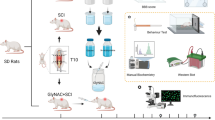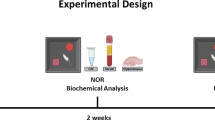Summary
Ducklings fed diets containing INH at level of 0.1% developed in a period of 4 weeks a tissue syndrome which was described previously as a spongy degeneration of the white matter (Carlton andKreutzberg). The formal pathogenesis was the subject of this study. Early changes were observed after 48 hours of administration of 0.15% INH. Severe alterations appeared in astroglia cells of the subependymal tissue and in deep roof nuclei of the cerebellum, cerebellar white matter, cerebellar peduncles and in the reticular formation of the medulla oblongata. Early changes included swelling of cell bodies and nuclei, formation of cytoplasmic vacuoles, and rupture of nuclei. Later, coalesence of vacuoles and rupture of cells resulted in the formation of microcysts creating a status spongiosus. By this process the INH encephalopathy can be defined basically as an oedematous change of the astrocytes followed by a liquefaction of these glia cells and ending in a vacuolization of the affected region simulating the tissue syndrome of spongy degeneration.
Zusammenfassung
Jungenten, die eine 0,1% INH-Diät erhielten, entwickelten innerhalb 4 Wochen ein Gewebssyndrom, das als spongiöse Degeneration der Marksubstanz beschrieben wurde (Carlton u.Kreutzberg). Ihre Formalpathogenese wurde untersucht. Frühe Veränderungen waren 48 Std nach Verabreichung von 0,15% INH nachweisbar. Schwere Läsionen traten in Astrocyten des subependymären Marklagers und in den tiefen Dachkernen des Kleinhirns, im Kleinhirnmark, in den Kleinhirnstielen und in der Formatio reticularis der Medulla oblongata auf. Die Frühveränderungen umfaßten Schwellung der Zellperikaryen und Kerne, Bildung cytoplasmatischer Vacuolen und Kernruptur. Später führten Confluens von Vacuolen und Zellrupturen zur Bildung von Mikrocysten mit Auftreten eines Status spongiosus. Durch diese Veränderungen kann die INH-Encephalopathie, grundsätzlich als eine ödematöse Veränderung der Astrocyten definiert werden, die von einer Verflüssigung dieser Gliazellen mit Ausgang in Vacuolisierung der betroffenen Gebiete und Ausbildung des Gewebssyndroms der spongiösen Degeneration gefolgt ist.
Similar content being viewed by others
References
Carlton, W.W., C. E. Hunt, andP. M. Newberne: Neural lesions induced in ducklings by isonicotinic acid hydrazide and semicarbaside hydrochloride. Exp. molec. Path.4, 438–448 (1965).
—, andG. Kreutzberg: Isonicotinic acid hydrazide-induced spongy degeneration of the white matter in the brains of Pekin ducks. Amer. J. Path.48, 91–105 (1966).
De Robertis, E. D. P., H. M. Gerschenfeld, andF. Wald: Some aspects of glial function as revealed by electron microscopy. In IV. Internat. Kongr. Elektronenmikroskopie, Bd. 2, pp. 443–447. Berlin, Göttingen, Heidelberg: Springer 1958.
Friede, R. L.: A histochemical study of DPN-diaphorase in human white matter with some notes on myelination. J. Neurochem.8, 17–30 (1961).
Hager, H., W. Hirschberger, andA. Breit: Electron microscope observations on the X-irradiated central nervous system of the Syrian hamster. Proc. Internat. Symposium on the Response of the Nervous System to Ionizing Radiation, pp. 261–275. Chicago: Academic Press 1960.
Marin, O., andJ. D. Vial: Neuropathological and ultrastructural findings in two cases of subacute spongiform encephalopathy. Acta neuropath. (Berl.)4, 218–229 (1964).
Meyer, J. E.: Über eine “Ödemkrankheit” des Zentralnervensystems im frühen Kindes-alter. Arch. Psychiat. Nervenkr.185, 35–51 (1950).
Niessing, K., u.W. Vogell: Elektronenmikroskopische Untersuchungen über Strukturveränderungen in der Hirnrinde beim Ödem und ihre Bedeutung für das Problem der Grundsubstanz. Z. Zellforsch.52, 216–237 (1960).
Pappenheimer, A. M., andM. A. Goettsch: Cerebellar disorder in chicks, apparently of nutritional origin. J. exp. Med.53, 11–26 (1931).
Pentchew, A.: Neuropathological tissue patterns and pathogenetic principles in intoxications and deficiencies (to be published in: Pathology of the nervous system, ed.J. Minckler.) New York: McGraw-Hill.
—,F. Garro, andP. Schweda: Dysoric encephalopathy in suckling rats produced by lead. Proc. V. Internat. Congress Neuropathology. Zurich 1965. Excerpte Medica. Int. Congr. Series Nr. 100. Amsterdam-New York: Excerpta Medica Foundation 1966.
Rubin, B., andJ. C. Burke: Absorption, distribution and excretion of isoniazid (hydrazid) in the dog. J. Pharmacol. exp. Ther.107, 219–224 (1953).
Seitelberger, F.: Problem of status spongiosus. In: Brain edema. Ed. byJ. Klatzo andF. Seitelberger: Vienna New York: Springer Publ. Co. 1967
Vogt, C., u.O. Vogt: Über die Neuheit und den Wert des Pathoklisenbegriffes. J. Psychol. Neurol. (Lpz.)38, 147–154 (1929).
Zeller, E. A., J. Barsky, J. R. Touts, W. F. Kirchheimer, andL. S. van Orden: Influence of isonicotinic acid hydrazide (INH) and 1-isonicotinyl-2-isopropyl hydrazide (IIH) on bacterial and mammalian enzymes. Experientia (Basel)8, 349–350 (1952).
Author information
Authors and Affiliations
Additional information
This investigation was supported in part by Research Grant HD-02055-01 from the National Institutes of Health, Bethesda, Md, U.S.A.
Rights and permissions
About this article
Cite this article
Kreutzberg, G.W., Carlton, W.W. Pathogenetic mechanism of experimentally-induced spongy degeneration. Acta Neuropathol 9, 175–184 (1967). https://doi.org/10.1007/BF00691442
Received:
Issue Date:
DOI: https://doi.org/10.1007/BF00691442




